NVIDIA’s GeForce GTX 480 and GTX 470: 6 Months Late, Was It Worth the Wait?
by Ryan Smith on March 26, 2010 7:00 PM EST- Posted in
- GPUs
Crysis: Warhead
It’s been over 2 years since the release of the original Crysis, and “but can it run Crysis?” is still a common question even today. With a mix of dense foliage, long draw distances, and high quality textures, Crysis is still a game that can bring any machine to its knees, and is our first choice for testing any video card.
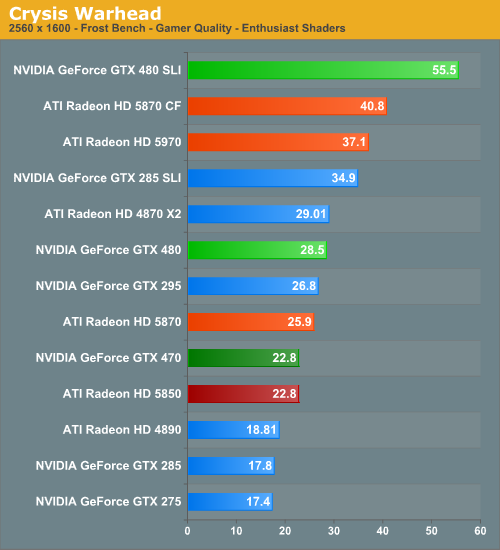
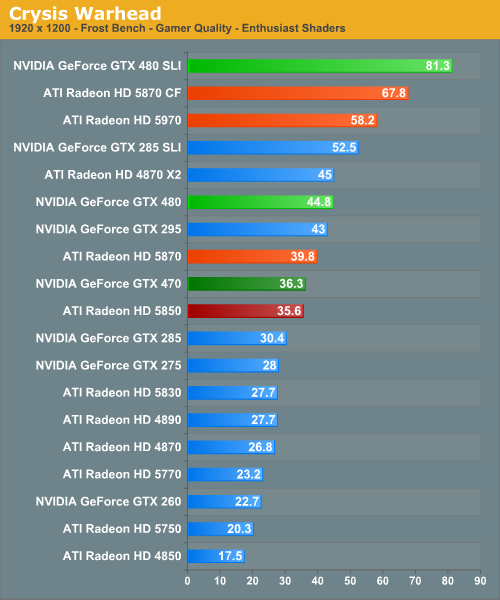

As far as this first game is concerned, things are looking so-so for NVIDIA. For the GTX 480, it’s in a solid 10-12% lead over the 5870, and unsurprisingly losing to the 5970. For the GTX 470 things are less rosy; it basically is breaking even with the 5850. Furthermore there’s an interesting pattern in our averages: the gap between the GTX 400 series and the Radeon 5000 series shrinks with resolution. Keep an eye on this, it’s going to be a repeating pattern.
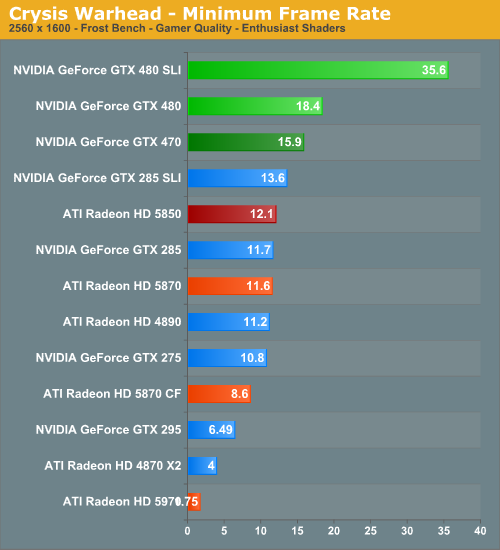
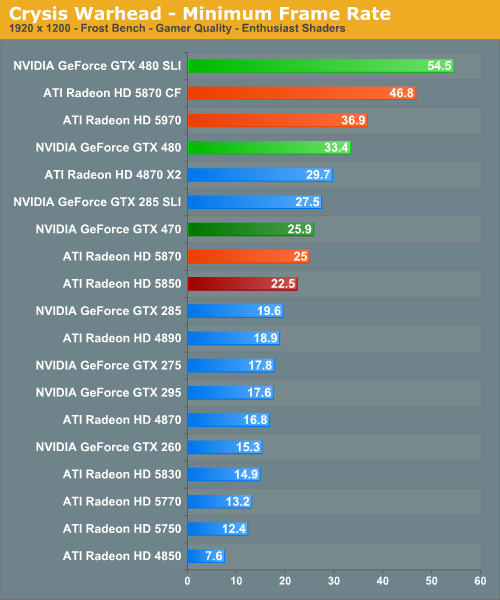
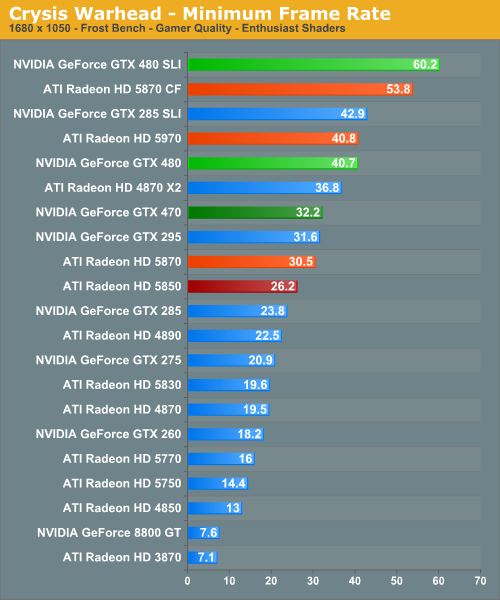
We’ve also gone ahead and recorded the minimum framerates for Crysis, as in our testing we’ve found the minimums to be very reliable. And in doing so, we have some data even more interesting than the averages. The GTX 400 series completely tramples the 5000 series when it comes to minimum framerates, far more than we would have expected. At 2560 Crysis is approaching a video RAM limitation in our 1GB and under cards, which gives the GTX 480 cards a clear lead at those resolutions. But even at lower resolutions where we’re not video RAM limited, the GTX 480 still enjoys a 33% lead in the minimum framerate, and the GTX 470 is well ahead of the 5850 and even slightly ahead of the 5870.
For whatever reason AMD can’t seem to keep up with NVIDIA when it comes to the minimum framerate, even at lower resolutions. Certainly it’s obvious when the 1GB cards are video RAM limited at 2560, but if we didn’t have this data we would have never guessed the minimum framerates were this different at lower resolutions.
Finally we have a quick look at SLI/CF performance. CF seems to exacerbate the video RAM limitations of the 5000 series, resulting in the GTX 480SLI coming in even farther ahead of the 5870CF. Even at lower resolutions SLI seems to be scaling better than CF.










196 Comments
View All Comments
Headfoot - Monday, March 29, 2010 - link
Great review, great depth but not too long. Concise but still enough information.THANK YOU SO MUCH FOR INCLUDING MINIMUM FRAME RATES!!! IMO they contribute the most to a game feeling "smooth"
niceboy60 - Friday, August 20, 2010 - link
This review is not accurate , Badaboom GTX 400 series cards , are not compatible with GTX 400 series yet .However they already post the test resaultsI have a GTX 480 and does not work with badaboom , Badaboom official site confirms that
slickr - Sunday, March 28, 2010 - link
I thought that after the line-up of games thread, you would really start testing games from all genres, so we can actually see how each graphic cards performs in different scenarios.Now you have 80% first person shooters, 10% racing/Action-adventure and 10%RPG and RTS.
Where are the RTS games, isometric RPG's, simulation games, etc?
I would really like Battleforge thrown out and replaced by Starcraft 2, DOW 2: Chaos Rising, Napoleon Total War. All these RTS games play differently and will give different results, and thus better knowledge of how graphic cards perform.
How about also testing The Sims 3, NFS:Shift, Dragon Age Origins.
Ryan Smith - Monday, March 29, 2010 - link
Actually DAO was in the original test suite I wanted to use. At the high end it's not GPU limited, not in the slightest. Just about everything was getting over 100fps, at which point it isn't telling us anything useful.The Sims 3 and Starcraft are much the same way.
Hsuku - Sunday, March 28, 2010 - link
On Page 9 of Crysis, your final sentence indicates that SLI scales better than CF at lower resolutions, which is incorrect from your own graphs. CF clearly scales better at lower resolutions when video RAM is not filled:@ 1680x1050
480 SLI -- 60.2:40.7 --> 1.48
5870 CF -- 53.8:30.5 --> 1.76 (higher is better)
@ 1920x1200
480 SLI -- 54.5:33.4 --> 1.63
5870 CF -- 46.8:25.0 --> 1.87 (higher is better)
This indicates the CF technology scales better than SLI, even if the brute performance of the nVidia solution comes out on top. This opposes diametrically your conclusion to page 9 ("Even at lower resolutions SLI seems to be scaling better than CF").
(Scaling ability is a comparison of ratios, not a comparison of FPS)
Ryan Smith - Monday, March 29, 2010 - link
You're looking at the minimums, not the averages.Hsuku - Tuesday, March 30, 2010 - link
My apologies, I was looking at the wrong graphs.However, even so, your assertion is still incorrect: at at the lowest listed resolution, CF and SLI scaling are tied.
Ryan Smith - Wednesday, March 31, 2010 - link
Correct. The only thing I really have to say about that is that while we include 1680 for reference's sake, for any review of a high-end video card I'm looking nearly exclusively at 1920 and 2560.Hrel - Thursday, September 2, 2010 - link
I get that, to test the card. But if you don't have a monitor that goes that high, it really doesn't matter. I'd really like to see 1080p thrown in there. 1920x1080; as that's the only resolution that matters to me and most everyone else in the US.Vinas - Sunday, March 28, 2010 - link
It's pretty obvious that anantech was spanked by nVIDIA the last time they did a review. No mention of 5970 being superior to the 480 is a little disturbing. I guess the days of "trusting anandtech" are over. Come on guys, not even a mention of how easily the 5870 overclocks? The choice is still clear, dual 5870's with full cover blocks FTW!